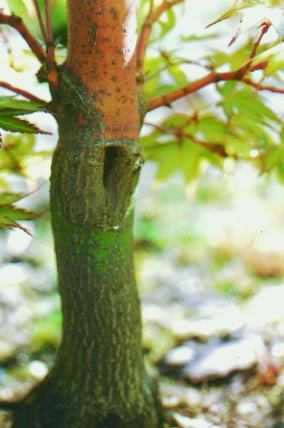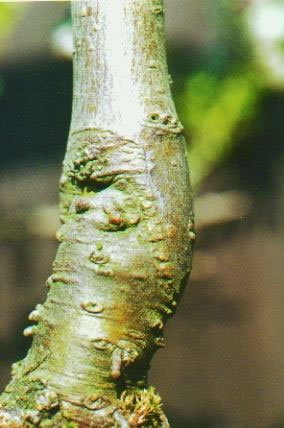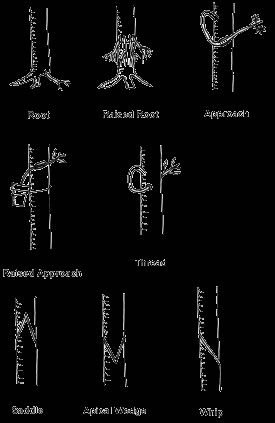
| |
| Home |
| Starter Trees |
| Bonsai |
| Yamadori |
| Accents |
| Services |
| Special Offers |
| Tutorials |
| Book & DVD Reviews |
| Links |
| Contact Us |
| Division & Grafting |
Two important techniques are considered here to conclude the series of articles on propagation. Division is a simpler propagation technique than most.Many plants possess multiple stems, each with its own root system, which can be carefully divided. Provided that this is done at the correct time of year, usually late spring, it is one of the easiest ways of increasing plant stocks. If possible, lift the plant with as much root as you can and assess where the most suitable pieces can be obtained from. It is helpful if some of the soil can be removed to reveal the major roots. Use a root cutter, secateurs or sharp saw to divide the plant into the required pieces. Abelia, many Bamboos, Cotoneaster, Escallonia, Pyracantha, and Quince may be divided in this way. Protection from sun and wind should be given for a while, as with any repotted plant. Most bamboos prefer to be kept warm and humid when they are divided like this. The new culms erupting from the soil indicate that they have taken and can be gradually reintroduced to the outdoors. If a plant is too large to lift and you want to remove a piece from the edge this can also be achieved. Inspect it carefully to find the most suitable piece, cutting back some of the top growth if necessary. Remove some soil until you find where the roots or stems are connected and sever carefully as above. The gardener's method of dividing herbaceous perennials with 2 forks back to back, may be employed on tough plants with a relatively thin root structure e.g. Ophiopogon, Hakonechloa, Ferns, Grasses and many others used for accent plants. Always take care not to damage the trunks of your potential bonsai. Trim any cuts cleanly and seal, then treat as a recently lifted plant. i.e. plant up in a well drained soil mix and give shade and wind protection until established. A cold greenhouse is the ideal place for this but is not essential. It may be advantageous to do some preliminary shaping and plant back in the ground, to allow the smaller plants time to thicken and grow, before potting up and refining. Suckers provide another source of divided plants. The difference is that the new growth that you remove is arising from the root, sometimes at a distance from the main plant. In these cases it is necessary to carefully excavate around the small plant and find the root that it arises from. Check that enough fibrous root has developed on the piece you wish to sever. If not, it’s best to encourage rooting by cutting part way through the root it is growing on and dusting with hormone. Cover with gritty soil and leave for a few months, to a year, before checking again. Elm, Winged Spindle (Euonymus), Wild Cherry or Gean, Sloe and many other Prunus are suited to this technique. Grafting
Grafting has long been used to join parts of one plant to another, in order to combine the relative strengths of both. Poor growers can be grafted onto stronger rootstock. Plants that cannot be induced to root from cuttings can be grafted onto an easily grown seedling stock. Old trees such as Prunus can be rejuvenated by grafting in new branches. New varieties can be secured from Witches Brooms. Faulty specimens can have new branch structures built onto the framework. Today grafting is sometimes used as a convenience measure by nurseries. Often the grafts produced make unsuitable bonsai material. The graft union is too high or uses a stock that has too obvious differences in diameter or bark type to the scion. High grafts can also suffer from vigorous suckering at the base, demanding constant vigilance to prevent the stock “taking over“. 
Many hobbyists are reluctant to try grafting as it is seen as an esoteric technique best left to the experts and nurserymen. However, it can be done with a little knowledge, minimal equipment and a willingness to experiment. One real advantage that grafting offers is that branches can be grown where they are needed. This allows trees that would otherwise be of no real value for use as a bonsai to be improved. Some species such as the dwarf Acers are difficult to propagate by cuttings and do not come true from seed, so this is the best way to increase stocks. A graft made low on the trunk (just above the root line) should become invisible in time. 
An undesirable graft, where there is a vast difference in bark characteristics and a large scar. (Acer palmatum Sango Kaku onto Japanese Mountain Maple) The main pre-requisites for successful grafting:- 1. Compatibility of species so that failure or rejection does not occur. 2. Cambial contact is crucial to ensure uninterrupted passage of foods up the trunk. You can practice identifying the cambium layer, using waste pieces removed during heavy pruning, Use a sharp blade to split the bark vertically and then peel it away, separating the bark from the wood inside. The cambium is the moist and slippery layer which is adhering to both the woody part of the trunk and the inside of the bark. 3. Tying secures the grafted portion in position until the graft union is completed. Clear, stretchy polythene grafting tape is now commonly used. This can perform sealing and tying in one operation. Other alternatives are plastic adhesive insulation tape (narrower than 20mm or 3/4"), rubber bands about 100mm (4") long, 5mm (3/8") wide and .75mm (1/32") thick and cut to open them out, old bicycle inner tubes can be cut to provide similarly sized pieces. All of these are easy to use and will expand as the graft union begins growth without causing constriction. If raffia is used, observe the graft closely to ensure that it does not cut into the bark, once growth commences. The tie should be carefully slit, once its job has been done, and allowed to drop off in its own time as the trunk expands. 4. Sealing must be done effectively so that the tree can heal without drying or diseases entering between the cut surfaces. Care must be taken that the sealant does not enter the cut and prevent the intimate contact that is necessary in the cambial layers. If a plastic grafting tape tie is done well, it should be air tight. Practise is needed to develop the technique, so that you can quickly obtain a secure tie. Other ties need sealing. Some of the options are:- Latex emulsion - wood glue, Unibond etc. forms a flexible colourless seal. "Hot" grafting waxes (e.g. Tenax) are warmed by placing the container in hot water so that a brushable consistency is reached. Paraffin wax as supplied for candle making is heated in a container placed in a pan of boiling water. This is suitable for smaller specimens that can be up-ended and dipped into the melted wax and then instantly cooled in water. 5. Correct time of year. For Pines January to February with bottom heat or March to the end of April under glass, Junipers can be attempted from April to July, Maples can be done in the summer with shade house protection. Bud grafts are usually done in mid to late summer. 
Types of GraftThe techniques illustrated here are the ones most frequently utilised in bonsai development. Many more are in general use.
Root GraftingRoot grafting is used to correct root problems e.g. one sided root development. The roots from seedling trees are grafted in at the soil line. Inarching & approach graftingA whippy branch is shaved on one side, bent around so that it sits in a corresponding cut made on the trunk. The branch is not cut away from its point of origin until the graft has healed and is growing on vigorously. Thread Grafting A hole is drilled through the trunk or branch and a flexible stem is passed through the hole until it wedges tightly and is then sealed with wax or latex. The stem thickens and in time fuses neatly around the hole edges on both sides. Once you are certain that it has bonded into the bark, cut away from the point of origin and hollow the stub on the opposite side with knob cutters so that it will heal tidily. Top Grafts Apical grafts such as Saddle, Whip or Whip & tongue.SaddleCut the stock to an inverted v and the scion to a v shape that will sit comfortable on top of the stock. Mostly used for Rhododendrons. Apical WedgeSpecies propagated by Apical Wedge:-Aesculus, Caragana arborescens 'Walker' onto C. arborescens, Cercis, Fagus, Syringa. WhipThis is the easiest and most commonly used method for joining stocks and scions of the same diameter. Whip & TongueVariation of the above requiring a little more skill in cutting the required shapes accurately. Species propagated by whip & tongue grafting:- Fraxinus, Gleditschia, Robinia, AcersBudding Mostly used for propagating varieties of fruit tress but can be very useful for getting branches where you want them on species such as Crab Apples. For detailed step by step photos see Plant Propagation by Bob Price & the RHS Encyclopedia of Gardening. Species propagated by budding:- Crataegus, Laburnum, Magnolia, Malus, Prunus, Pyrus, Sorbus. Side Veneer or Side WedgeSpecies propagated by side veneer grafting:-Abies, Acer Palmatum cultivars onto A. palmatum seedlings, Aralia, Arbutus, Betula, Camellia, Caragana, Carpinus, Cedrus, Cupressus, Fagus, Fraxinus, Ginkgo, Gleditschia, Hamamelis, Larix, Magnolia, Picea, Pinus, Prunus, Sorbus.  My first side veneer Pine graft. A piece collected from the witches broom shown in the photo at the top of this page. Now well established and ready for the "snag" (left of the graft) to be removed. My first side veneer Pine graft. A piece collected from the witches broom shown in the photo at the top of this page. Now well established and ready for the "snag" (left of the graft) to be removed.
This is a horticultural skill that will always be a mystery to you if you are unwilling to experiment. Give it a try and you could soon have another skill that enables you to make the very best of your trees. For the most comprehensive advice on grafting see "The Grafters Handbook" - Garner, for more Bonsai specific notes "Art of Bonsai" - Adams & "Bonsai" - Dan Barton. All Text & Photographs © Kevin Bailey 1998 - 2008
|

